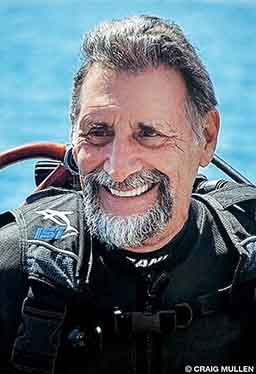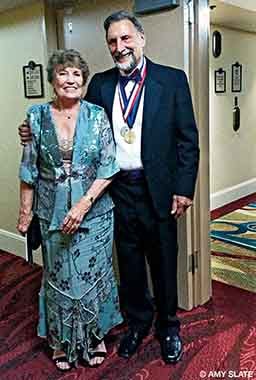Hometown: Palo Alto, Calif.
Years Diving: 61
Favorite Dive Destination: Irian Jaya
Why I’m a DAN® Member: It gives me great confidence to know that if I have a diving accident I will be speedily and properly treated.

As a child, Ian Koblick dreamed of becoming an explorer like Daniel Boone. He has since fulfilled that ambition by becoming a pioneer of the least-studied frontier on Earth: the ocean. Koblick was first drawn to underwater exploration when his father showed him a National Geographic article about William Beebe, who used a deep-sea submersible called the bathysphere to conduct dives off the coast of Bermuda in the 1930s. A few decades later, Koblick would carry out his own marine research as one of the world’s first aquanauts.
His diving career began unceremoniously; he conducted minor salvage operations in homemade gear for about $10 per job. After graduating with a degree in biology from Chico State University, he attended a summer session at Stanford University’s Hopkins Marine Station, where he scoured the coast in search of bits of seaweed to add his herbarium. Growing tired of scavenging seaweed on the beach, Koblick wanted to see the algae in its natural habitat and planned some exploratory dives with a friend. Despite the excellent specimens Koblick collected, his professor at the time was not impressed.
“I remember her saying, ‘Diving is for adventurers, and if you want to be a scientist, you will collect like a scientist,’” Koblick said. The young diver remained undaunted, however, even turning down a graduate fellowship at Duke University, vowing instead to find a way to live and work in the sea.

“I did not see how a man could ever begin to know or understand the ocean unless he was able to visit and live in it,” Koblick explained. So in 1964 he and his wife, Tonya, moved with their 9-month-old son to St. Thomas, U.S. Virgin Islands, where they began working as science teachers. Koblick soon immersed himself in the diving, boating and salvage communities. When the opportunity arose for him to be part of an underwater research mission now famously known as Tektite, he jumped at the chance. For Koblick, it was like “being chosen as an astronaut to be sent to the moon.”
The 58-day Tektite I mission ended in 1969 with a perfect safety record, proving that humans could live and work safely in the sea for an extended time. Finally living his earliest dreams, Koblick was determined to continue this pioneering work, so he wrote and presented a proposal to the legislature of the U.S. Virgin Islands, convincing the government to allocate some of the funding for the second mission. In 1970 Koblick continued his work as an aquanaut and helped manage the science missions for Tektite II, which included the first all-female aquanaut team. After the successful completion of Tektite II, Koblick, now Special Assistant to the Governor of the Virgin Islands for Undersea Programs, founded the Marine Resources Development Foundation (MRDF), which aimed to foster a greater understanding of the ocean’s resources.

Buoyed by the success of the MRDF, Koblick persuaded the governor of Puerto Rico to fund an undersea research program known as the Puerto Rico International Undersea Laboratory (PRINUL). He relocated to Puerto Rico and started to work on building a new undersea habitat designed to be quickly and easily moved and deployed — it was named La Chalupa as a nod to the flat-bottomed boats used by Puerto Rican fishermen that were notorious for sinking in the open ocean. One of the most innovative and technologically advanced underwater habitats of its time, La Chalupa achieved major successes in the development of ocean research and saturation-diving technology.
Koblick managed the MRDF from Puerto Rico until he moved to Florida in 1976. There he began working with the U.S. Department of Commerce to establish a national ocean program designed to promote undersea exploration and education. In addition to his government work, he served as a consulting editor of the NOAA Diving Manual and coauthored Living and Working in the Sea with Jim Miller in 1984.

Partnering with Neil Monney, Koblick acquired La Chalupa from Puerto Rico, moved it to Key Largo, Fla., and converted it into the world’s first submerged hotel, the Jules’ Undersea Lodge, which opened in 1986. With its entrance located 21 feet underwater, the hotel caters to recreational divers and has hosted thousands of guests, including astronauts, marine scientists, celebrities and government officials. The lodge is next to MRDF’s MarineLab, an underwater research and environmental education facility that hosts field trips and outreach programs for students.

In 2003, Koblick and Craig Mullen established the Aurora Trust Foundation “to advance the world’s understanding of the ocean environment, most particularly its marine cultural heritage hidden for thousands of years on the seafloor….” As with all of Koblick’s projects, Aurora aims to cultivate public interest in marine science and exploration. The organization conducts archeological research in the Mediterranean Sea, which has led to dozens of discoveries: from shipwrecks on ancient Greco-Roman trade routes to ships, airplanes and unexploded ordinance from World War II.
Although Koblick admits the obvious appeal of finding relics unseen by human eyes for thousands of years, his foremost endeavor through Aurora is to educate the public about the fascinating historical role the oceans have played in connecting people through culture, commerce and conflict. Even as he plans his next undersea expedition in the Mediterranean, his primary interest remains education, and he knows that engaging students through learning is the first step to getting them to care.
“Teaching the next generation about the importance of exploring the ocean is the most critical thing we can do,” Koblick explained. Fortunately, given the success of his endeavors, his enthusiasm for the ocean seems to be contagious.

